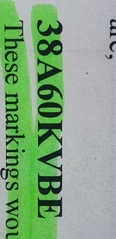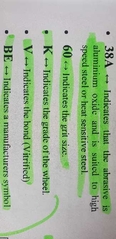![]()
![]()
![]()
Use LEFT and RIGHT arrow keys to navigate between flashcards;
Use UP and DOWN arrow keys to flip the card;
H to show hint;
A reads text to speech;
83 Cards in this Set
- Front
- Back
|
4 advantages of grinding |
Only on cutting tool. Very hard components easily machined. High degree of surface finish. High degree of accuracy . |
|
|
6 wheel selection factors |
Arc of contact. Material to be ground. Finish required. Amount of material being removed. Use of coolant. Operation being done. |
|
|
5 abrasive types |
Aluminum oxide. Silicon carbide. Diamond. Cubic boron nitride. Seaded gel |
|
|
Aluminum oxide type A application |
Low alloy steel |
|
|
Aluminum oxide type 38a application |
Heat sensitive hard steels |
|
|
Aluminum oxide type 19A application |
Precision general purpose grinding of soft to tough steel |
|
|
Aluminum oxide type 32A application |
High alloy heat sensitive steels. Cool and fast cutting |
|
|
Aluminum oxide type 23A application |
Centerless grinding |
|
|
Aluminum oxide type ZF,ZS application |
Fast cutting ,low wear & high pressure. |
|
|
Silicon carbide 37C applications |
Grind hard brittle material |
|
|
Silicon carbide 39C applications |
Grinding carbide and other extremely hard man made materials. |
|
|
Diamond applications and coding. |
Coding D. Non ferrous materials. |
|
|
Cubic boron nitride application and coding |
Coding B. Hardened ferrous materials and super alloys. |
|
|
Seeded gel application, SG |
Grind harder materials longer between dressing vs aluminum oxide. |
|
|
Define Grit size |
Actual size of grit held in the wheel. 10 coarsest 》600 finest |
|
|
3 considerations for grit size. |
Material to be ground. Finish required. Arc of contact. |
|
|
The coarser the grit |
The cooler the wheel will cut. |
|
|
Grade of wheel defined as |
Hardness of the bond that holds the grit |
|
|
Hardness of A 》G wheel |
Very soft |
|
|
Hardness of H 》K wheel |
Soft |
|
|
Hardness of L 》O wheel |
Medium |
|
|
Hardness of P 》S wheel |
Hard |
|
|
Hardness of T 》Z wheel |
Very Hard |
|
|
6 types of bonds and their code |
Vitrified (v). Resinoid (b). Shellac (e). Rubber (r). Silicate (s). Magnisite (mg). |
|
|
Bond able to handle side pressure |
Resinoid |
|
|
Bond used to produce high quality finish |
Shellac |
|
|
Bond used for extremely thin wheels |
Rubber |
|
|
Bond used for low heat applications |
Silicate |
|
|
Bond used for resiliant steels |
Magnisite |
|
|
3 wheel structure designations |
0 》3 close spacing . 4 》6 medium spacing. 7 》12 open spacing |
|
|
5 wheel ordering details needed |
Diameter of wheel. The wheel thickness. Bore diameter. Shape of the wheel. Wheel composition marking. |
|
|
6 wheel markings |
Abrasive. Grit size. Grade. Structure. (Can be omitted) Bond. Bond type if modified. (Can be omitted) |
|

This wheel marking ? |

|
|
|
3 checks before fitting wheel |
Condition. Max RPM. Ring test. |
|
|
A wheel is dropped or cracked you should... |
Inform the NCO and it must be destroyed and disposed. |
|
|
10 step wheel fitting procedure. |
Mount wheel. Balance. Mount to spindle. Fit guards. Run wheel. True the wheel. Rebalance. Remount. Adjust guards. True and dress for use. |
|
|
3 things causing wheel imbalance. |
Coolant in wheel from not being run out. Wheel slipping between flanges. Loose balance weights. |
|
|
3 wheel faults. |
Loading. Glazing. Dressing. |
|
|
5 things causing loaded wheels. |
Material too soft for grade of wheel. Dirty/insufficient coolant. Wheel structure to close. Grit too fine. Insufficient dressing. |
|
|
6 glazing causes. |
Wheel to hard. Wheel speed too high. Low work speed. Cut too light. Insufficient coolant. Blunt dressing diamond. |
|
|
Dressing vs truing. |
Dressing improves cutting action. Truing alters the shape of the wheel. |
|
|
10 dressing points |
Sharp diamond for roughing, broad for finish. Turn diamond frequently. Drag angle 10 to 15 degrees. On or below center line. Diamond secure. Grinder warmed up. Contact at highest point first. Coolant before diamond touches. 0.001" dress depth. Slow traverse for finish. |
|
|
5 faults caused by dressing errors. |
Blunt diamond. Erratic traverse. Poorly supported diamond. Dressing too infrequent. Lack of coolant when dressing. |
|
|
6 wheel storage points. |
Handle with care. Stored in dry areas. Thin wheel stored flat. No wheel to wheel contact. Avoid temperature extremes. Store out of sunlight. |
|
|
12 safe use points of grinding wheels |
Correct wheel. Ring Test. Don't exceed max safe speed. Never enlarge spindle bore. Clean smooth blotter per side. Clean flanges covering 1/3 of wheel dia. Spindle nut only tightened firmly. Use wheel guards. Dress often Contact work carefully, no bump/crash. 5 minute run before turning off. Protect unused wheels. |
|
|
6 coolant properties |
Cooling agent. Wash away swarf. Transparent. Correct dilution. Antiseptic. Lubricating. |
|
|
8 construction points of grinder. |
Bed. Table. Workhead. Tailstock. Traverse system. In feed system. Coolant system. Hydraulic system. |
|
|
8 cylindrical grinding accessories. |
Chucks. Face plates. Dead centers. Collets. Mag chucks. Headstock live or dead centers. Steadies. Wheel dressers. |
|
|
Traverse rate |
1/2 to 2/3 of wheel width per revolution of work |
|
|
Wheel amount off job. |
1/3 to 2/3 wheel off the edge of the job but not completely off. |
|
|
Increased traverse rate precaution |
Table inertia increases so adjust trip dogs so there is no over run / crashing. |
|
|
Work head speed starting point is 30-50 SFPM , influenced by what 4 things. |
Arc of contact. Material being ground. Feed rate and required finish. Rigidity. |
|
|
6 cylindrical grinding operations. |
Round. Tapered. Facing. Internal. Radius. Grinding to shoulder. |
|
|
4 centerless grinding lobing causes. |
Original stock out of round. Work rest being flat topped. Centers on the same height. To much pressure.
|
|
|
Centerless feed methods. |
In feed. End feed. Through feed. |
|
|
5 things to prepare ground items for use |
Deburring. Cleaning. Stress relieving. Corrosion Prevention. Packing and handling. |
|
|
4 tool and cutter wheels |
Straight wheel. Straight cup. Tapered or flared cup. Saucer or dish wheel. |
|
|
14 tool and cutter accessories. |
Radius attachment. Indexing head. Centers. Tooth rest. Tail stock. Air bearing spindle. Dressers Spindles. Mag tables. Powered work head. Tap grinding attachment. Guards. Wheels. |
|
|
Set up basics tool and cutter |
Select accessories. Calculate wheel speed. Grinding on or off tooth. Calculate clearance angle. |
|
|
Clearance angle formula. |
H=r sin X H= tool rest from cutter center r= radius of cutter X= clearance angle required |
|
|
Tool and cutter operations |
Sharpen. Form grinding. |
|
|
Surface grinding machines. |
Horizontal spindle, reciprocating table. Horizontal spindle, rotary table. Vertical spindle, reciprocating table. Vertical spindle, rotary table. Face grinder. |
|
|
6 mag table procedures. |
De-burr prior to placing on table. Hand stone damage out. Occasionally grind table flat. Lightly oil and cover after use. Clean paper under large jobs for irregularities. Placed for maximum flux flow. |
|
|
Surface grinder operations. |
Flat. Tapered. Vertical. Formed. |
|
|
Honing process is used to |
Eliminate inaccuracies from previous operations. Generate final dimensions for standardization. Rapid and economical stock removal. Create high surface finish quality. |
|
|
Stock to leave on for honing rule of thumb. |
less than 1/2'' = .003 to .005 thou 1/2 to 1" = .005 to .007 thou over 1" = .007 to .010 thou |
|
|
Honing oil designed to. |
Handle machining pressure for fast cutting. Wash away swarf and abrasive. Increase stone life. Assist in finish quality. |
|
|
Hone machine accessories. |
Mandrels. Stones. Truing sleeve. Dressing stick. |
|
|
Hone stone used for cast iron, Aluminium, Brass and Bronze. |
Silicone carbide , J stone. |
|
|
Hone stone used for steels. |
Aluminium oxide, A stones. |
|
|
Hone stone used for Ceramic and Glass. |
Diamond, D stones. |
|
|
Hone stone used for extremely hard steels or production runs. |
CBN stones. |
|
|
3 hone general rules |
Harder the material softer the abrasive. Rapid reciprocating increases cut speed. Finer grit grade for better finish. |
|
|
When a new stone is fitted you should. |
Carry out a Truing In operation. |
|
|
How often should the hone truing sleeve be rotated? |
After every 3 to 4 stroke. |
|
|
The hone truing process is complete when . |
The stone and guide shoes are radiused and showing full contact. |
|
|
When the hone stones appear loaded the remedy is. |
To use the dressing stick to clean any loading from the stone. |
|
|
8 common honing faults. |
Bell mouthing. Taper. Poor finish. Slow material removal. Poor stone life. Glazing. Loading. Barreling. |
|
|
Lapping is used to produce. |
Extreme accuracy. Correct minor imperfections. Refine surface finishes. Extreme close fit between mating surfaces. |
|
|
3 types of lapping machines. |
Metal lap with loose abrasive and lubricant. Flat/profiled plate with bonded abrasives. Replaceable abrasive cloth or paper. |
|
|
2 lapping methods. |
Wet, with surplus lubricant and abrasive. Fast. Dry, lap charged prior to use. Slower. |
|
|
Lapping abrasives. |
Carborundum for fast removal of hard steel. Emery, garnet, unfused alumina. Fused alumina. Diamond. |
|
|
7 lubricants used for lapping . |
Lard oil. light machine oil. Gasoline. Kerosene. Turpentine. Alcohol. Soda water. |

